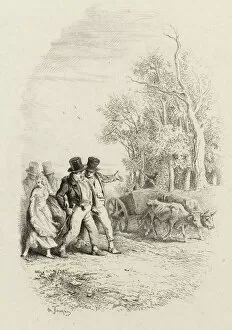Jacque Charles Collection (#7)
Jacque Charles, a renowned artist of the 19th century, left an indelible mark on the art world with his captivating works
For sale as Licensed Images
Choose your image, Select your licence and Download the media
Jacque Charles, a renowned artist of the 19th century, left an indelible mark on the art world with his captivating works. His paintings captured scenes that ranged from serene landscapes to poignant human emotions. In "The Well" (1845), Jacque masterfully depicted a rustic well surrounded by lush greenery, evoking a sense of tranquility and simplicity. The viewer is transported to a peaceful countryside where time seems to stand still. Moving on to "Edge of a Wood, under Cloudy Sky" (1846), Jacque showcased his ability to capture the ever-changing moods of nature. The dark clouds looming over the woods create an atmosphere filled with anticipation and mystery. One cannot overlook Jacque's talent for portraying human subjects as seen in "Drinker, " where he skillfully portrayed the raw vulnerability and solitude of an individual lost in their thoughts. Similarly, in "Beggar with Basket" (1844), he shed light on societal inequalities through his empathetic portrayal of poverty. Jacque also delved into capturing moments between people, as evident in "Two Smokers" (c. 1845). This painting exudes camaraderie and companionship as two individuals share a momentary respite from their daily lives. Nature remained one of Jacque's favorite subjects throughout his career. In "The Banks of a River" (1846), he beautifully depicted the serenity and harmony found along riverbanks – inviting viewers to immerse themselves in its calming presence. A windmill stands tall against the sky in another masterpiece titled simply "Windmill" (1846). With meticulous brushstrokes, Jacque brought this iconic symbol to life while showcasing his technical prowess. Jacque's love for rural life shines through in paintings such as "Plowing" (c. 1865) and "Landscape with Cowherd" (c. 1865).












